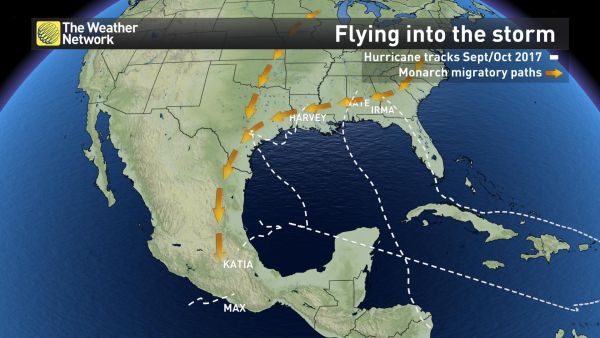Michoacán, Mexico - It seems monarch butterflies haven't fared very well when it comes to weathering the storms of the past fall and winter seasons.
Despite increasing awareness about their decades-long decline, a new survey out of Mexico - where the colorful butterflies spend the winter - indicates the amount of ground used by the monarchs for their winter retreat was nearly 15 percent smaller in December of 2017 than the previous winter.
Famous for their annual migration, monarchs swarm to a small section of south-central Mexico each fall, embarking on the 5000 km trip beginning around mid-September. There are several main 'thoroughfares' for the insects, but most of the creatures from the central and eastern United States and Canada follow paths that take them on a two-month-long trek down along the Gulf Coast or Mississippi Valley, and then through Texas.
A Case of Bad Timing
 |
In previous years the report, released by WWF-Telmex Telcel Alliance, in coordination with Mexico's National Commission for Protected Areas (CONANP), has pointed the finger at increasing extreme weather events as a "new, ominous threat to the monarch butterflies' key wintering habitat." Climate change and its effect on North America was again mentioned in this year's report.
But it wasn't just the storms that may have thrown last year's migration off course. Above-average temperatures also dominated the western half of the continent through the early autumn; a factor that may have delayed the butterflies' migration until well into October, according to the WWF.
That means that, by the time the butterflies did start their trip south, they would have faced colder temperatures and less vegetation on their way.
A Worrying Trend
In the second half of December 2017, researchers surveyed 9 sanctuaries with a historical presence of monarch colonies. Every 15 days, they determined the location, the perimeter occupied, and temperature of active 'hibernation' sites. In this winter's survey, five colonies of monarchs were documented inside the Monarch Butterfly Biosphere Reserve, with four more outside.
The results showed a 14.77 percent drop in the amount of territory taken up by the species compared to the winter of 2016-17. While that's higher than the very lowest recent observation, in the winter of 2013-14, the overall trend is still not good for the black and orange insects.
"In the last 20 years, we have seen a steady decrease of the area that monarch butterflies cover in their hibernation grounds in Mexico; from almost 45 acres (18.19 ha) of forest in December 1996, to only 6.1 acres (2.48 ha) in December of 2017, indicating a worrisome situation in the monarch's population status," said Jorge Rickards, CEO of WWF in Mexico.
"Extreme weather conditions, illegal logging, and habitat destruction are the main threats. But how many monarch butterflies arrive to hibernate to the mountains of Mexico depend on how many can survive during their migration route in the United States, Canada and Mexico," added Rickards.
One way to help the monarchs closer to home is to give them a place to stop along the way, in the form of butterfly-friendly plantings in spring and fall. Milkweed - the only thing monarch butterfly caterpillars eat - is crucial to the survival of the species, and is unfortunately one of the native North American plants that's losing ground to expanding cities and changing land use.
Sources: NHC • WWF-Telmex Telcel Alliance • WWF Canada • Learner.org


